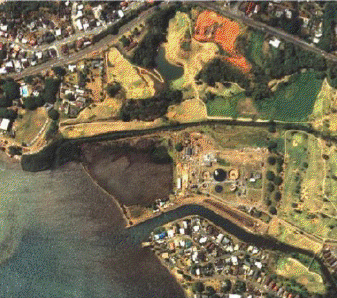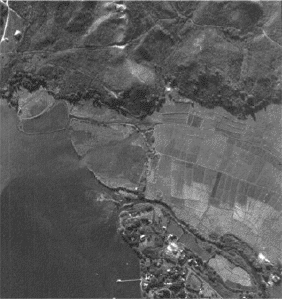Waikalua Loko Fishpond is a loko kuapā—a type of fishpond that is unique to these Islands. Waikalua Loko I’a was built about 350 years ago.
At that time, the ahupua’a flourished with productive lo’i kalo (taro patches) fed by the waters of Kawa and Kāne’ohe streams. The waters flowed from the streams through ‘auwai (ditches) into the loʻi and into the loko I’a (fishponds). The original pond received fresh water from both Kāneʻohe and Kawa streams. Grates once controlled the flow of water from these streams into the pond so that pond managers could control the salinity of the water.
The original locations of the mākāhā (sluice grates) on the makai side and the dimensions of the pond walls are not known.
The current sea levels are higher than at any time in the past, due to climate change.
According to S. Kamakau, in the 13th century, a Tahitian chief known as La’amaikahiki sailed from Tahiti to Kane’ohe and landed at what is known as Waikalua. (Note: Kihei’s research refers to the site as Waihaukalua or the place where Waikalua fishpond is today)
We suspect the name derives fom “dirty water of the pit” or two dirty water places since it is always brown in that area because of the streams flowing from mauka.
La’amaikahiki named the area known as Waikalua and the Kokokahi Y site as Naoneala’a (the sands so La’a) It is considered the place that La’amaikahiki introduced the “pahu hula” in Hawaii. It is also known as a place to greet other pacific islanders.
Kamehameha III is the son of Kamehameha the great and Keopuolani (she is considered the highest rank of any living Hawaiian) Kamehameha III is also the longest reigning King 1824-1854 of all Hawaii’s Kings. Kalama is considered a maka’ainana rank…
Charles Coffin Harris, originally lawyer from New Hampshire, gains the favor the King Kamehameha V and becomes minister of foreign affairs, and eventually Chief Justice of the Hawaiian Supreme Court serving all the way to King Kalakaua’s time. C.C. Harris is either given or sold the Waikalua loko fishponds as we know it today. Harris dies in the early 1880’s and sells it to the Botelho brothers. The Botleho’s are the precursor to the James B. Castle ranch which includes most of Kaneohe and Kailua. Castle turns into Kaneohe Ranch that we know of today.
Henry Wong was a land manager for Kaneohe Ranch for over 35 years. Upon his retirement, he is given certain lands fro his good service to the ranch. It includes the Waikalua fishpond and what is known today as the Bayview golf course and surrounding area.
The Waikalua Loko Fishpond Preservation Society in partnership with PAF develops a new model for culture -based curriculum utilizing the pond as the cultural resource to teach math, science, social studies and language arts.
The Native Hawaiian Education Council in 2005 selects the Kahea Loko curriculum project as a new model and helps to publish it online. In 2007, the Hawaii Department of Education awards PAF a “partners in excellence award for Kahea Loko and the new Aloha aina (ahupua’a) curriculum projects. To date, nearly 1,500 teachers are trained reaching nearly 50,000 students statewide. Between 3 to 5,000 students/community member visit and or conduct classes at the pond yearly.
In 2016, the Society declared its 20 year mission to restore the fishpond complete, and ownership was transferred to the Pacific American Foundation. Ongoing restoration efforts, educational projects, water quality testing and data analysis, and cultural activities are enjoyed by students, families, and community.
Present day issues being addressed include climate change, sea level rise, pollution, invasive species, and safe, plentiful food cultivation using a combination of ancient practice and knowledge and modern scientific inquiry and practice.
| 1650 | Estimated date of original construction by Hawaiians. (Eugene Dashiell et al, 1995) | |
| 1887 | The pond has extensive lo’i kalo mauka and a small interior pond where mullet fry were probably grown. | |
| 1900 | The pond’s area of 13.4 acres was in full commercial operation. Today the pond is 11.6 acres). | |
| 1926 | There was a large break in the makai pond wall. | |
| 1930 | The pond walls (mākāhā) were constructed of reinforced concrete, with stone faces filled with cobbles and coral, and with three openings. The 9 to 12 feet wide wall may have been widened for access by equipment. | |
| 1940-1950 | Water quality and the marine environment have been impacted by human activities. More than 11 million cubic yards of coral was dredged in Kāne’ohe Bay and sugar and pineapple cultivation led to extensive soil erosion and siltation of the bay. A sewage outfall was constructed near Waikalua Loko.  |
|
| 1967 | An aerial photo shows a channelized Kawa Stream that flows directly into the bay. Today the mouth of this stream is covered in silt and mangrove. This same photo shows a ditch next to the pond and the sewage treatment plant that appears to connect both streams. Ongoing development in the uplands of the Kāne’ohe ahupua’a created serious soil erosion into the bay. Introduced mangrove plants became a major management challenge at the pond. Mr. Koyama, the pond operator in the 1960s, reported a mullet harvest of 100 pounds per month (not a commercially viable yield). | |
| 1970 | Pond operation stopped. Flood control efforts led to channelization of Kāne’ohe Stream, which was dammed at Ho’omaluhia Park. Portions of Kawa Stream were lined with concrete and the stream was further channelized. Sewage discharge to Kāne’ohe Bay was stopped and diverted to Mōkapu Point. | |
| 1995 | The Waikalua Loko Fishpond Preservation Society was formed to help mālama the pond for use as an educational site. | |
| 1998 | Castle High School Science Teacher, Sheila Cyboron, brings first group of students (grade 11 and 12) to study science in the context of the fishpond;The transformation in student motivation and learning inspires a new level of culture-based curriculum development. | |
| 2000 | WLFPS partners with the Pacific American Foundation (PAF), the Hawaii Department of Education and and the University of Hawaii Sea Grant program and receives its first major curriculum development grant award from the U. S. Department of Education entitled “Kāhea Loko, the Call of the pond.” | |
| 2003 | Kāhea Loko program is welcomed by teachers; statewide workshops are scheduled and over 330 teachers sign up for training in the standards-based curriculum. | |
| 2004 | Pacific American Foundation, the Society, the Hawaii DOE partner again and receive its second major grant award called “Aloha ‘Āina.” It focuses on the Kāne’ohe ahupua’a (mountain to the sea). | |
| 2007 | Aloha ‘Āina is also a very welcome addition to schools’ curricula and the project trains nearly 380 teachers; both Kāhea Loko and Aloha ‘Āina receive a “Partners in Education” award from the Hawaii Department of Education. | |
| 2009 | In partnership with the University of Hawaii at Windward and the Hawaii Institute of Marine Biology, the Society and PAF, the U. S. Housing and Urban Development (HUD) awards the group a grant to purchase the Waikalua Loko Fishpond and grant title to PAF. | |
| 2011 | The Historic Hawai’i Foundation selects the Waikalua Loko Fishpond and the Society with its highest honor for exemplary preservation of a cultural resource. | |
| 2013 | PAF acquires Waikalua Loko (17 plus acres) from current landowner utilizing HUD funds. First ancient Hawaiian fishpond to return to Hawaiian hands since the great mahele in 1848. | |
| 2014 | PAF receives another major award from the U.S. Department of Education under the Native Hawaiian Education Act called “Kulia” that focus on students grade 7 -12 on the Windward Side of Oahu to pursue studies and career opportunities in natural resources management, marine science and conservation; PAF becomes ‘Hub” partner with NOAA, EPA, HIMB, University of Hawaii Windward and the Smithsonian Institute to accelerate collective impact. | |
| 2015 | PAF Hawaii Inc. is created to maximize benefits and support from State and Local governments as a long-term sustainable strategy to continue education, cultural preservation and environment stewardship of site and surrounding areas. | |
| Today | Since 2000, over 4,000 teachers have been trained in the various curricula developed by PAF (see Ulukau.org; Search: Hawaiian curriculum materials) Approximately 5,000 students, families and community members visit the pond every year to learn about this special place. Community members regularly come to care for the pond (Lā Hana) –to remove invasive mangrove, seaweed, pick up marine debris, and repair walls.
The work of students, community groups, and the Waikalua Loko Fishpond Preservation Society has breathed new life back into Waikalua Loko. As each stone is put back on the wall and each native plant takes root, we build the foundation for a healthier future that honors the rich cultural and natural heritage of the Kāne’ohe ahupua’a. |
|
